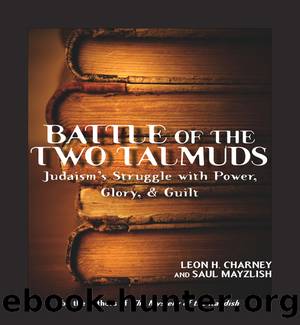Battle of the Two Talmuds by Mayzlish Saul Charney Leon & SAUL MAYZLISH

Author:Mayzlish, Saul, Charney, Leon & SAUL MAYZLISH [H. CHARNEY, LEON]
Language: eng
Format: epub
ISBN: 978-1-56980-439-1
Publisher: Barricade Books
PART TWO
• 8 •
TWO TALMUDS: TWO SCHOOLS OF THOUGHT
ALTHOUGH THE TALMUD at first looks disorderly and inconsistent, it was actually put together in a very concise and accurate manner, the editors making sure to include all the authentic sources and mentions of every doubtful case. The citations and arguments are classified and distinguished according to the source (Mishnah, baraita, or amora’s opinion). There is also a special marking of the kinds of questions, and a distinction is made between the various questions, refutes, and those contradictions and difficulties still open to be solved. Also there is a meaning to the order in which the items are presented, that applies to the weight of a possible solution.
This accuracy of the editing work, which is the fruit of generations of work, made the Talmud very consistent and open to fixed methods of study and interpretation. Its editing work caused the Talmud, which is strictly speaking not a book of laws, to serve as a first-class legal source, and thanks to the strictness of its method of thought as well as its writing and style of expression, to continue to be created in subsequent generations as well.
An interesting difference between the two Talmuds is reflected in their attitude toward the Hasmonean Rebellion (led by Judah Maccabee) and attempts to divert the focus of the Hanukkah holiday from the heroic figures of the Hasmoneans toward the divine miraculous aspect. And indeed the Babylonian Talmud depicts the history of Israel from the Hasmonean Rebellion up to the failure of Bar Kokhba, citing reconciliation trends with the foreign rulers and expressing reservations about war and rebellion.
The authentic Israeli tradition is reflected in the Jerusalem Talmud. It sees the rebellion as just and avoids condemning the rebels, and also it does not contain any reconciliatory remarks about the victorious enemy. It does not demand avoidance of any unconditional objection and actual deeds.
In contrast, the Babylonian Talmud displays a passive and antirevolutionary attitude, consistent adjustment to the conditions of exile and continued subjection. The Babylonian Talmud does not mention initiated rebellions in order not to mention erida Bamakhut, the rebellion of the rulers, and the breaching of the explicit prohibition to Lid’chok et Haketz (to speed up Redemption). There are no revolutionary movements in the Babylonian Talmud that sweep the multitudes, no messianic slogans, and no public leadership that evokes rebellion. In contrast, the Jerusalem Talmud does not see the story of Hanukkah, for example, as a simple victory but rather as a symbol of the triumph of spiritual light over darkness.
Download
This site does not store any files on its server. We only index and link to content provided by other sites. Please contact the content providers to delete copyright contents if any and email us, we'll remove relevant links or contents immediately.
| Africa | Americas |
| Arctic & Antarctica | Asia |
| Australia & Oceania | Europe |
| Middle East | Russia |
| United States | World |
| Ancient Civilizations | Military |
| Historical Study & Educational Resources |
The Light of Days by Judy Batalion(827)
Stalin's War: A New History of World War II by Sean McMeekin(688)
Walk in My Combat Boots by James Patterson(614)
The Pacific War 1941-1943 by James Holland(608)
Victory's Price (Star Wars) by Alexander Freed(577)
The Vietnam War: An Intimate History by Geoffrey C. Ward & Ken Burns(569)
First Platoon: A Story of Modern War in the Age of Identity Dominance by Annie Jacobsen(562)
Cold War (Alexander King Book 2) by Bradley Wright(558)
The American War in Afghanistan by Carter Malkasian(555)
Operation Pedestal by Max Hastings(538)
Blood and Ruins: The Great Imperial War, 1931-1945 by Richard Overy(531)
The Madman Theory by Jim Sciutto(521)
Concepts of Space by Jammer Max;(518)
Extreme Fitness by Chris McNab(514)
World War II Infantry Fire Support Tactics by Gordon L. Rottman(502)
Flying Tiger by Samson Jack(500)
Pathfinders by AL-KHALILI JIM(496)
Panzerkrieg by Mike Syron(488)
Hitler’s Pre-Emptive War: The Battle for Norway, 1940 by Henrik O. Lunde(484)
